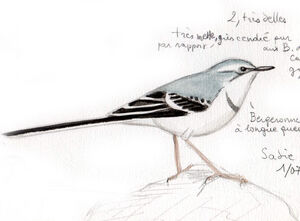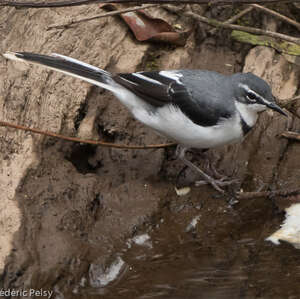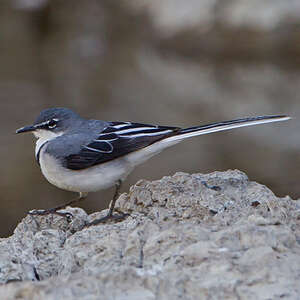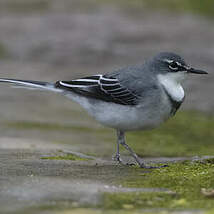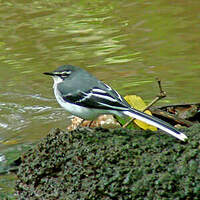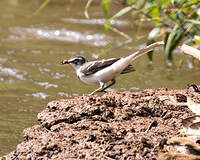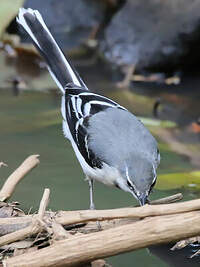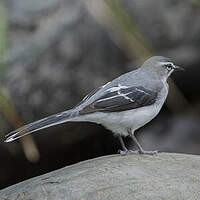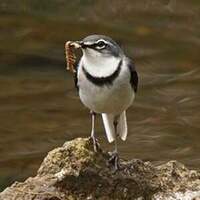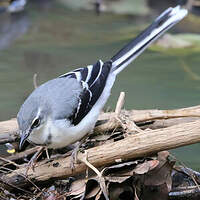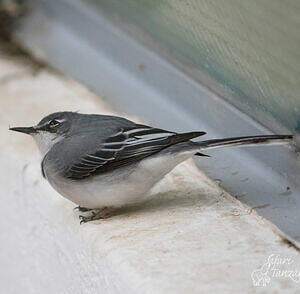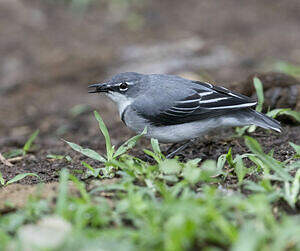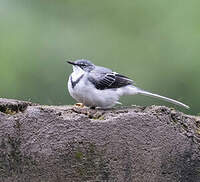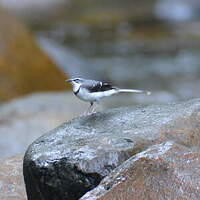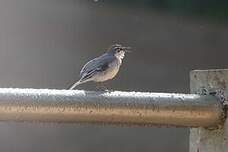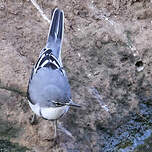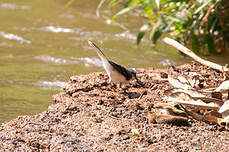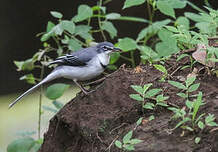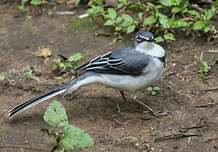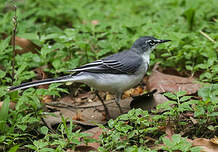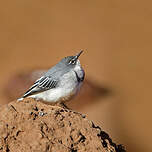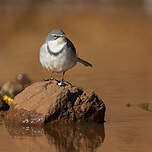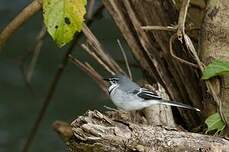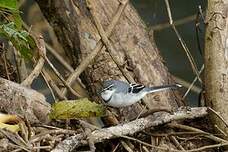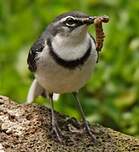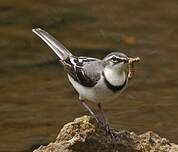Mountain Wagtail
Motacilla clara - Bergeronnette à longue queue
Identification
With its slender silhouette and long tail, the Mountain Wagtail fits very well with the idea of a Motacillid. Its tail is slightly longer than that of other species of the genus Motacilla. Its silhouette is reminiscent of the Pied Wagtail. There is no sexual dimorphism. Three colors dominate the plumage, gray, white and black, a bit like our Grey Wagtail. The upper parts are entirely gray from the beak to the tail, with the shade varying according to the subspecies. The wings are black, with the large coverts and especially the tertiary remiges largely bordered in white. The gray head shows a narrow and clear white eyebrow highlighted by the almost black lores stretching a little behind the eye. The black eye is surrounded by white, the upper crescent blending with the eyebrow. The especially long and thin beak is black. The tail is two-tone with the 3 central rectrices mainly black and the 3 outer rectrices completely white. The lower parts are very light. The only truly white parts are the throat and the top of the chest. The latter has a narrow, full black collar in its middle. The rest of the underside is white to grayish, especially on the sides of the chest and the flanks. The legs are black. The 3 subspecies differ little from each other. Compared to the type subspecies: M. c. torrentium has shorter wings, a proportionally longer tail, and wider white borders on the wings; M. c. chapini has darker upper parts. The juvenile looks like an adult, except that it does not have a black collar on the chest.
Subspecific information 3 subspecies
- Motacilla clara clara (Ethiopia)
- Motacilla clara chapini (Sierra Leone to Central African Republic, c DRCongo and Gabon)
- Motacilla clara torrentium (e Uganda and c Kenya to c Angola, Zambia, Zimbabwe and w Mozambique, also e South Africa)
Foreign names
- Bergeronnette à longue queue,
- Lavandera clara,
- alvéola-rabilonga,
- Langschwanzstelze,
- hosszúfarkú billegető,
- Bergkwikstaart,
- Ballerina montana,
- bergärla,
- Bergerle,
- trasochvost potočný,
- konipas bystřinný,
- Afrikansk Bjergvipstjert,
- koskivästäräkki,
- Bergkwikkie,
- cuereta clara,
- pliszka jasna,
- Длиннохвостая трясогузка,
- ハイイロハクセキレイ,
- 非洲山鹡鸰,
- 麗鶺鴒,
Voice song and cries
The song of the Mountain Wagtail is soft and rather faint in intensity. The musical phrases are short but regularly repeated : ti-tuu-ui-Tui-Tui or tsrrrrup, tsrrrrup, tsrrrrup.... The call is a loud, metallic-toned chirrup or chizzik. On takeoff, the Mountain Wagtail usually emits a drawn-out two-syllable note sreeeeeeeeh or treeedrurrup. The alarm cry is a phweep or chweep.
Habitat
The Mountain Wagtail primarily favours humid habitats, from low- lying areas to altitudes of 2,000 metres. It prefers rivers with steep banks, rocks and stones, waterfalls and cascades amongst hillsides and dense undergrowth. It can also be found away from water, on wooded tracks, pathways and roads, sometimes even in gardens. In this way it reminds us of the Grey Wagtail.
Behaviour character trait
If the Mountain Wagtail of the ssp clara is sedentary in Ethiopia, it is rather nomadic in the rest of East Africa and in South Africa.
There could also be short migration movements in West Africa.The Mountain Wagtail is quite solitary. Not shy, it can easily be observed when, alongside streams, it is looking for its food. It walks, runs, swirls, so many dynamic attitudes that it is pleasant to observe in it. It can be common, but it is neither gregarious nor colonial. At most, one can observe 4 or 5 individuals simultaneously occasionally for a short period of time. It does not seem to gather in nocturnal dormitories.
The species is monogamous. Once the couple is formed, the partners stay together for life. Once the breeding site is chosen, it is also kept for life.
Flight
Dietfeeding habits
The Mountain Wagtail is an insectivore in the wider sense of the word. It primarily feeds on diptera but odonates, lepidopterans, coleopterans, trichopterans and plecopterans are also part of its diet.
Occasionally, it can consume slugs, tadpoles and small fish. Faecal samples studied in Ethiopia on one side and South Africa on the other were primarily composed of chitinous remains of diptera for the first country and of odonate larvae for the second.The Mountain Wagtail feeds in various ways. Along shallow streams it hops from rock to rock, advances on partially submerged tangles or branches, or simply strolls the bank, plucking the insects that appear. It can also catch insects in flight.
Reproduction nesting
The Mountain Wagtail is a monogamous species, with couples usually staying together all year round. However, when the breeding season comes, both partners re-initiate courtship. With their wings lowered and vibrating, their tail feathers raised and fanned out like an umbrella, the male wagtail will court its female by running and dancing around her on the ground, sometimes even engaging in aerial pursuits. Breeding cycles differ depending on the area: they begin from January to April, September to November in Ethiopia, March to July in Malawi, in May and August to December in South Africa, and all year round in Tanzania.
Both partners share the responsibilities involved in nesting, constructing a large cup-shaped nest with a base made of consciously dampened materials that adheres to the spotting when it goes dry, made of rootlets, leaves, stalks and other fibers from plants. The site for the nest must have free-flowing water nearby, usually in tree hollows, on rocks or rock walls, on bridges, dams or even sometimes under a man-made roof. Usually, once a suitable site is found, the same one will be used for nesting year after year, with the couple alternatively maintaining or repairing it as necessary. The female then lays 1 to 4 eggs, which are incubated by both sexes for 13 to 14 days.The incubation sequences range from 15 to 60 minutes. The chicks are permanently brooded for the first 4 days of their lives and are fed by both parents. After this deadline, the brooding becomes irregular and definitively stops on the eighth day. The young leave the nest after 14 to 18 days while still staying on the family territory under the dependency of their parents. This last phase varies according to individuals and can last until the forty-eighth day of life.Geographic range
The Mountain Wagtail is a sub-Saharan species. Its range is fragmented. The type subspecies inhabits the heights of Ethiopia. It is found in Chad, West Africa, and Central Africa (Guinea, Liberia and Sierra Leone on one side, Cameroon and Gabon on the other). Finally, the much larger range of torrentium covers a tenth of countries between the north of the Democratic Republic of the Congo and the south of South Africa, with a centre of gravity on the south of the Democratic Republic of the Congo, the south-west of Tanzania and the north of Zambia.
Threats - protection
IUCN conservation status
concern
in the Wild
threatened
evaluated
The Mountain Wagtail is locally common and globally not threatened. Water pollution as well as deforestation and the resulting erosion can however have negative effects on the species.
Sources of information
- IOC World Bird List (v14.1), Gill, F and D Donsker (Eds). 2024-04-18.
- Birds of East Africa: Kenya, Tanzania, Uganda, Rwanda, Burundi, Terry Stevenson, John Fanshawe
- HBW Alive,
- Biodiversity explorer The web of life in Southern Africa,
Other sources of interest
 Specification sheet created on
22/07/2023 by Nathalie Santa Maria
Specification sheet created on
22/07/2023 by Nathalie Santa MariaTranslation by AI Oiseaux.net
published: 14-12-2017 - Updated: 19-03-2018
© 1996-2024 Oiseaux.net
- Accipitriformes
- Aegotheliformes
- Anseriformes
- Apodiformes
- Apterygiformes
- Bucerotiformes
- Caprimulgiformes
- Cariamiformes
- Casuariiformes
- Charadriiformes
- Ciconiiformes
- Coliiformes
- Columbiformes
- Coraciiformes
- Cuculiformes
- Eurypygiformes
- Falconiformes
- Galliformes
- Gaviiformes
- Gruiformes
- Leptosomiformes
- Mesitornithiformes
- Musophagiformes
- Nyctibiiformes
- Opisthocomiformes
- Otidiformes
- Passeriformes
- Pelecaniformes
- Phaethontiformes
- Phoenicopteriformes
- Piciformes
- Podargiformes
- Podicipediformes
- Procellariiformes
- Psittaciformes
- Pterocliformes
- Rheiformes
- Sphenisciformes
- Steatornithiformes
- Strigiformes
- Struthioniformes
- Suliformes
- Tinamiformes
- Trogoniformes

